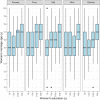Quantifying the association of natal household wealth with women's early marriage in Nepal
- PMID: 35003910
- PMCID: PMC8684741
- DOI: 10.7717/peerj.12324
Quantifying the association of natal household wealth with women's early marriage in Nepal
Abstract
Background: Women's early marriage (<18 years) is a critical global health issue affecting 650 million women worldwide. It is associated with a range of adverse maternal physical and mental health outcomes, including early childbearing, child undernutrition and morbidity. Poverty is widely asserted to be the key risk factor driving early marriage. However, most studies do not measure wealth in the natal household, but instead, use marital household wealth as a proxy for natal wealth. Further research is required to understand the key drivers of early marriage.
Methods: We investigated whether natal household poverty was associated with marrying early, independently of women's lower educational attainment and broader markers of household disadvantage. Data on natal household wealth (material asset score) for 2,432 women aged 18-39 years was used from the cluster-randomized Low Birth Weight South Asia Trial in lowland rural Nepal. Different early marriage definitions (<15, <16, <17 and <18 years) were used because most of our population marries below the conventional 18-year cut-off. Logistic mixed-effects models were fitted to estimate the probabilities, derived from adjusted Odds Ratios, of (a) marrying at different early ages for the full sample and for the uneducated women, and (b) being uneducated in the first place.
Results: Women married at median age 15 years (interquartile range 3), and only 18% married ≥18 years. Two-thirds of the women were entirely uneducated. We found that, rather than poverty, women's lower education was the primary factor associated with early marriage, regardless of how 'early' is defined. Neither poverty nor other markers of household disadvantage were associated with early marriage at any age in the uneducated women. However, poverty was associated with women being uneducated.
Conclusion: When assets are measured in the natal household in this population, there is no support for the conventional hypothesis that household poverty is associated with daughters' early marriage, but it is associated with not going to school. We propose that improving access to free education would both reduce early marriage and have broader benefits for maternal and child health and gender equality.
Keywords: Adolescence; Child marriage; Education; Natal household poverty; Nepal; Reproductive health; South Asia; Women’s early marriage.
© 2021 Marphatia et al.
Conflict of interest statement
The authors declare that they have no competing interests.
Figures



Similar articles
-
Where have I got to? Associations of age at marriage with marital household assets in educated and uneducated women in lowland Nepal.PeerJ. 2024 Aug 7;12:e17671. doi: 10.7717/peerj.17671. eCollection 2024. PeerJ. 2024. PMID: 39131621 Free PMC article.
-
The role of education in child and adolescent marriage in rural lowland Nepal.J Biosoc Sci. 2023 Mar;55(2):275-291. doi: 10.1017/S0021932022000074. Epub 2022 Apr 1. J Biosoc Sci. 2023. PMID: 35361308
-
How Much Education Is Needed to Delay Women's Age at Marriage and First Pregnancy?Front Public Health. 2020 Jan 9;7:396. doi: 10.3389/fpubh.2019.00396. eCollection 2019. Front Public Health. 2020. PMID: 31993411 Free PMC article.
-
Women's Marriage Age Matters for Public Health: A Review of the Broader Health and Social Implications in South Asia.Front Public Health. 2017 Oct 18;5:269. doi: 10.3389/fpubh.2017.00269. eCollection 2017. Front Public Health. 2017. PMID: 29094035 Free PMC article. Review.
-
Does bride price harm women? Using ethnography to think about causality.Evol Hum Sci. 2024 May 3;6:e29. doi: 10.1017/ehs.2024.21. eCollection 2024. Evol Hum Sci. 2024. PMID: 39220763 Free PMC article. Review.
Cited by
-
Associations of age at marriage and first pregnancy with maternal nutritional status in Nepal.Evol Med Public Health. 2022 Jul 25;10(1):325-338. doi: 10.1093/emph/eoac025. eCollection 2022. Evol Med Public Health. 2022. PMID: 35935708 Free PMC article.
-
Where have I got to? Associations of age at marriage with marital household assets in educated and uneducated women in lowland Nepal.PeerJ. 2024 Aug 7;12:e17671. doi: 10.7717/peerj.17671. eCollection 2024. PeerJ. 2024. PMID: 39131621 Free PMC article.
-
Like mother like daughter, the role of low human capital in intergenerational cycles of disadvantage: the Pune Maternal Nutrition Study.Front Glob Womens Health. 2025 Jan 20;5:1174646. doi: 10.3389/fgwh.2024.1174646. eCollection 2024. Front Glob Womens Health. 2025. PMID: 39902161 Free PMC article.
References
-
- Amin S. Empowering adolescent girls in rural Bangladesh: Kishori Abhijan. New York: Population Council; 2007.
-
- Ayral K. A Steep Climb Uphill: does geography and environment create barriers to secondary-aged girls’ equitable access to, and participation in education in remote areas of Nepal? 2014. Unpublished MSc thesis. London: London South Bank University.
LinkOut - more resources
Full Text Sources

